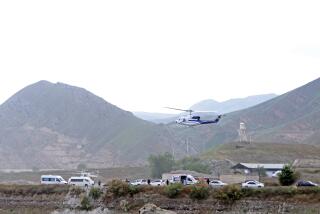Crew Exhumes Storm Wall Parts in New Orleans
The Army Corps of Engineers dug up two sections of the storm walls along the 17th Street Canal in New Orleans on Tuesday, trying to resolve conflicting information about why the levee failed during Hurricane Katrina.
Since the flood last summer, investigators have tried to determine exactly how far into the ground the foundation’s steel piling extended.
For the record:
12:00 a.m. Dec. 18, 2005 For The Record
Los Angeles Times Sunday December 18, 2005 Home Edition Main News Part A Page 2 National Desk 1 inches; 39 words Type of Material: Correction
New Orleans levees -- An article in Wednesday’s Section A about investigations of the levee system described Robert Crear, chief of the Army Corps of Engineers’ Mississippi River Valley Division, as a major general. He is a brigadier general.
The engineers, assisted by construction crews with massive cranes, extracted eight pieces of piling and found that they were all 23 feet long. That means they were originally implanted with 17 feet below sea level and the remaining 6 feet above sea level.
The results show that the pilings were not as shallow as some earlier evidence had suggested. But questions remain about whether they were deep enough -- and how that may have played into the levee failure.
Last month, a team of Louisiana State University experts using sonar equipment concluded that the steel sheet pilings went 10 feet deep. And Monday, an engineering firm hired by the corps released results of different sonar readings that indicated the pilings were as shallow as 9.7 feet below sea level.
When the 17th Street storm wall failed, a section more than 400 feet long was pushed into a residential neighborhood, along with the earth levee under the wall. Engineers have said the levee was too weak for the forces it encountered.
Maj. Gen. Robert Crear, the Army Corps of Engineers chief for the Mississippi River Valley, said Tuesday’s findings showed that the sheet piling met all of the corps’ specifications.
“What we have done is verify that the length of the piles was the correct length,” Crear said.
Crear said he believed that the levee system was never designed for a hurricane as powerful as Katrina, a conclusion some independent investigators have rejected.
“Hurricane Katrina was of a magnitude that the system was not designed for,” Crear said. “Some people forget that the hurricane was what caused the levees to fail.”
Crear apparently was speaking for the corps; he is not formally part of the investigation.
That team, which was appointed by the head of the corps, is being led by a University of Maryland levee expert.
The work Tuesday to dig up the sheet piling was done by the corps’ staff that is rebuilding levees in New Orleans, an organization known as Task Force Guardian.
Wayne Stroupe, a spokesman for the investigation team, said that a fair amount of cooperation was occurring between crews doing repairs and the investigators, though they are supposed to be independent bodies. On Tuesday, only a few members of the formal investigation team were there.
Crear said the corps was spending $1.6 billion to restore and improve levees around New Orleans. He expressed confidence that the repairs would be completed before the 2006 hurricane season, which starts in June. He said the residents of New Orleans had “very good reason to have a lot of confidence in the corps.”
More to Read
Start your day right
Sign up for Essential California for news, features and recommendations from the L.A. Times and beyond in your inbox six days a week.
You may occasionally receive promotional content from the Los Angeles Times.







